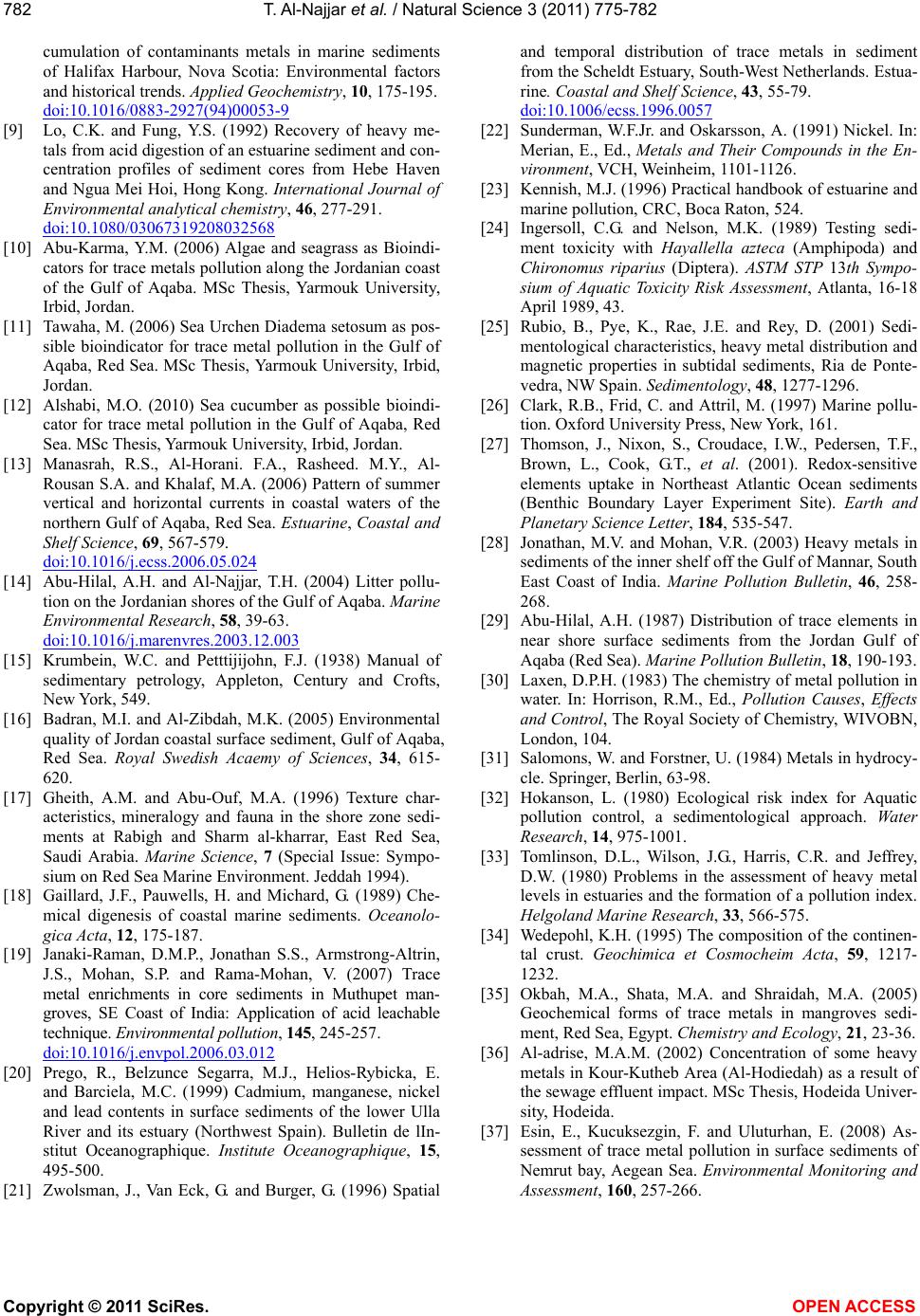
T. Al-Najjar et al. / Natural Science 3 (2011) 775-782
Copyright © 2011 SciRes. OPEN ACCESS
782
cumulation of contaminants metals in marine sediments
of Halifax Harbour, Nova Scotia: Environmental factors
and historical trends. Applied Geochemistry, 10, 175-195.
doi:10.1016/0883-2927(94)00053-9
[9] Lo, C.K. and Fung, Y.S. (1992) Recovery of heavy me-
tals from acid digestion of an estuarine sediment and con-
centration profiles of sediment cores from Hebe Haven
and Ngua Mei Hoi, Hong Kong. International Journal of
Environmental analytical chemistry, 46, 277-291.
doi:10.1080/03067319208032568
[10] Abu-Karma, Y.M. (2006) Algae and seagrass as Bioindi-
cators for trace metals pollution along the Jordanian coast
of the Gulf of Aqaba. MSc Thesis, Yarmouk University,
Irbid, Jordan.
[11] Tawaha, M. (2006) Sea Urchen Diadema setosum as pos-
sible bioindicator for trace metal pollution in the Gulf of
Aqaba, Red Sea. MSc Thesis, Yarmouk University, Irbid,
Jordan.
[12] Alshabi, M.O. (2010) Sea cucumber as possible bioindi-
cator for trace metal pollution in the Gulf of Aqaba, Red
Sea. MSc Thesis, Yarmouk University, Irbid, Jordan.
[13] Manasrah, R.S., Al-Horani. F.A., Rasheed. M.Y., Al-
Rousan S.A. and Khalaf, M.A. (2006) Pattern of summer
vertical and horizontal currents in coastal waters of the
northern Gulf of Aqaba, Red Sea. Estuarine, Coastal and
Shelf Science, 69, 567-579.
doi:10.1016/j.ecss.2006.05.024
[14] Abu-Hilal, A.H. and Al-Najjar, T.H. (2004) Litter pollu-
tion on the Jordanian shores of the Gulf of Aqaba. Marine
Environmental Research, 58, 39-63.
doi:10.1016/j.marenvres.2003.12.003
[15] Krumbein, W.C. and Petttijijohn, F.J. (1938) Manual of
sedimentary petrology, Appleton, Century and Crofts,
New York, 549.
[16] Badran, M.I. and Al-Zibdah, M.K. (2005) Environmental
quality of Jordan coastal surface sediment, Gulf of Aqaba,
Red Sea. Royal Swedish Acaemy of Sciences, 34, 615-
620.
[17] Gheith, A.M. and Abu-Ouf, M.A. (1996) Texture char-
acteristics, mineralogy and fauna in the shore zone sedi-
ments at Rabigh and Sharm al-kharrar, East Red Sea,
Saudi Arabia. Marine Science, 7 (Special Issue: Sympo-
sium on Red Sea Marine Environment. Jeddah 1994).
[18] Gaillard, J.F., Pauwells, H. and Michard, G. (1989) Che-
mical digenesis of coastal marine sediments. Oceanolo-
gica Acta, 12, 175-187.
[19] Janaki-Raman, D.M.P., Jonathan S.S., Armstrong-Altrin,
J.S., Mohan, S.P. and Rama-Mohan, V. (2007) Trace
metal enrichments in core sediments in Muthupet man-
groves, SE Coast of India: Application of acid leachable
technique. Environmental pollution, 145, 245-257.
doi:10.1016/j.envpol.2006.03.012
[20] Prego, R., Belzunce Segarra, M.J., Helios-Rybicka, E.
and Barciela, M.C. (1999) Cadmium, manganese, nickel
and lead contents in surface sediments of the lower Ulla
River and its estuary (Northwest Spain). Bulletin de lIn-
stitut Oceanographique. Institute Oceanographique, 15,
495-500.
[21] Zwolsman, J., Van Eck, G. and Burger, G. (1996) Spatial
and temporal distribution of trace metals in sediment
from the Scheldt Estuary, South-West Netherlands. Estua-
rine. Coastal and Shelf Science, 43, 55-79.
doi:10.1006/ecss.1996.0057
[22] Sunderman, W.F.Jr. and Oskarsson, A. (1991) Nickel. In:
Merian, E., Ed., Metals and Their Compounds in the En-
vironment, VCH, Weinheim, 1101-1126.
[23] Kennish, M.J. (1996) Practical handbook of estuarine and
marine pollution, CRC, Boca Raton, 524.
[24] Ingersoll, C.G. and Nelson, M.K. (1989) Testing sedi-
ment toxicity with Hayallella azteca (Amphipoda) and
Chironomus riparius (Diptera). ASTM STP 13th Sympo-
sium of Aquatic Toxicity Risk Assessment, Atlanta, 16-18
April 1989, 43.
[25] Rubio, B., Pye, K., Rae, J.E. and Rey, D. (2001) Sedi-
mentological characteristics, heavy metal distribution and
magnetic properties in subtidal sediments, Ria de Ponte-
vedra, NW Spain. Sedimentology, 48, 1277-1296.
[26] Clark, R.B., Frid, C. and Attril, M. (1997) Marine pollu-
tion. Oxford University Press, New York, 161.
[27] Thomson, J., Nixon, S., Croudace, I.W., Pedersen, T.F.,
Brown, L., Cook, G.T., et al. (2001). Redox-sensitive
elements uptake in Northeast Atlantic Ocean sediments
(Benthic Boundary Layer Experiment Site). Earth and
Planetary Science Letter, 184, 535-547.
[28] Jonathan, M.V. and Mohan, V.R. (2003) Heavy metals in
sediments of the inner shelf off the Gulf of Mannar, South
East Coast of India. Marine Pollution Bulletin, 46, 258-
268.
[29] Abu-Hilal, A.H. (1987) Distribution of trace elements in
near shore surface sediments from the Jordan Gulf of
Aqaba (Red Sea). Marine Pollution Bulletin, 18, 190-193.
[30] Laxen, D.P.H. (1983) The chemistry of metal pollution in
water. In: Horrison, R.M., Ed., Pollution Causes, Effects
and Control, The Royal Society of Chemistry, WIVOBN,
London, 104.
[31] Salomons, W. and Forstner, U. (1984) Metals in hydrocy-
cle. Springer, Berlin, 63-98.
[32] Hokanson, L. (1980) Ecological risk index for Aquatic
pollution control, a sedimentological approach. Water
Research, 14, 975-1001.
[33] Tomlinson, D.L., Wilson, J.G., Harris, C.R. and Jeffrey,
D.W. (1980) Problems in the assessment of heavy metal
levels in estuaries and the formation of a pollution index.
Helgoland Marine Research, 33, 566-575.
[34] Wedepohl, K.H. (1995) The composition of the continen-
tal crust. Geochimica et Cosmocheim Acta, 59, 1217-
1232.
[35] Okbah, M.A., Shata, M.A. and Shraidah, M.A. (2005)
Geochemical forms of trace metals in mangroves sedi-
ment, Red Sea, Egypt. Chemistry and Ecology, 21, 23-36.
[36] Al-adrise, M.A.M. (2002) Concentration of some heavy
metals in Kour-Kutheb Area (Al-Hodiedah) as a result of
the sewage effluent impact. MSc Thesis, Hodeida Univer-
sity, Hodeida.
[37] Esin, E., Kucuksezgin, F. and Uluturhan, E. (2008) As-
sessment of trace metal pollution in surface sediments of
Nemrut bay, Aegean Sea. Environmental Monitoring and
Assessment, 160, 257-266.